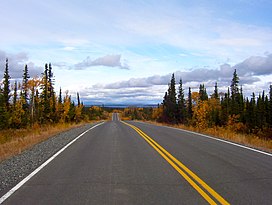| Copper Plateau taiga | |
|---|---|
 Lake Louise, Alaska from a distance | |
 Map of the Copper Plateau taiga. | |
| Ecology | |
| Realm | Nearctic |
| Biome | Boreal forests/taiga |
| Borders | |
| Geography | |
| Area | 17,257 km2 (6,663 sq mi) |
| Country | United States |
| State | Alaska |
| Climate type | Subarctic (Dfc) |
| Conservation | |
| Conservation status | Relatively stable/intact [1] |
| Protected | 5,195 km2 (30%) [2] |
The Copper Plateau taiga is an ecoregion of North America, as defined by the World Wildlife Fund (WWF) categorization system and the Commission for Environmental Cooperation, in the Taiga and Boreal forests, Biome, Alaska.